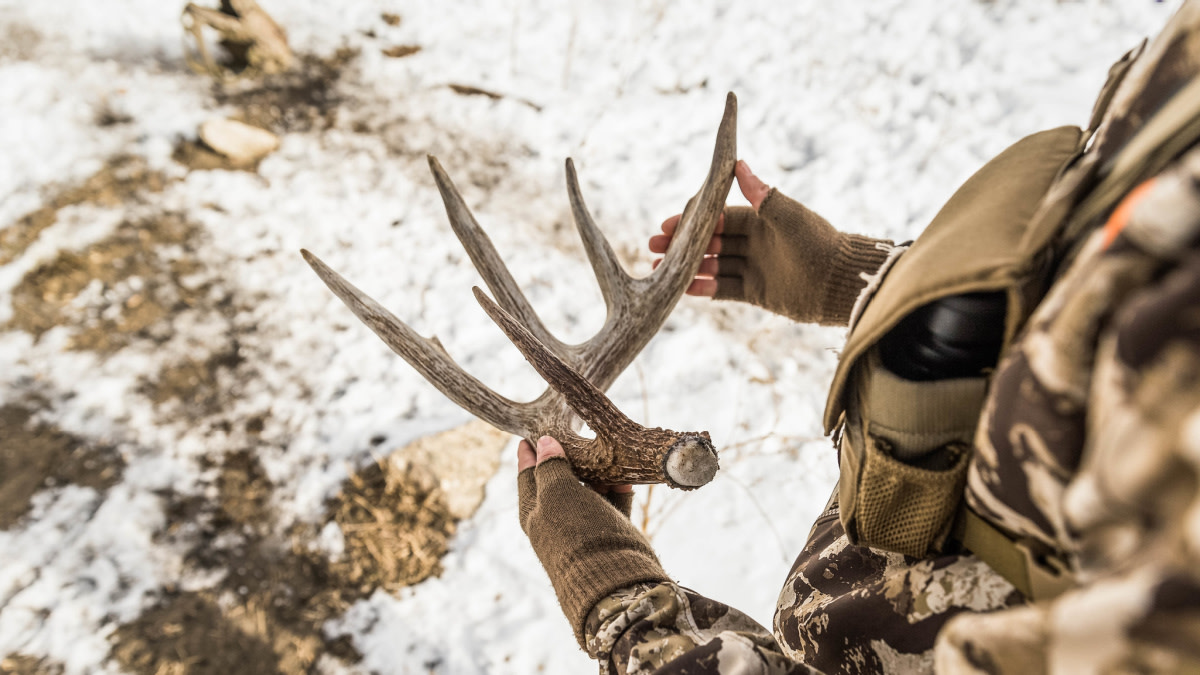
Shed hunting is one of those outdoor pursuits that sounds easy: Walk some trails, check some fence crossings, and fill up your backpack with antler. If you’ve got primo spots and plenty of time, this is probably true (and you likely don’t need to read an article about why you suck at shed hunting). But if your shed missions take you to public dirt or any ground where the competition is thick, it won’t be so easy. In this case, especially for beginners, an entire winter might pass without scooping up a single shed.
A realistic goal for most shed hunters is to simply find a few antlers each year. If you want to go from picking up two or three drops to five or six, then Minnesota shed hunter Joe Shead says it starts with focus.
Your Eyes Wander
“It’s so elementary, but you’ve got to keep your eyes on the ground,” Shead said. “A lot of times I’ll be shed hunting with someone, and they’ll ask if I saw the rubs we just walked past, but I will have totally missed them because my focus is always on the ground.”
Shead’s advice is simple, but it’s harder to accomplish than it sounds. Most of us enter the winter woods with mixed goals. Shed hunting might top the list when we get out of our truck, but an hour of antler-less walking can cause our attention to drift. Before long we’re looking for last year’s deer sign, eyeballing potential treestand sites, or scouting for an upcoming squirrel hunt. This moves our focus to areas where sheds can’t be found.
Just like with mushroom hunting, agate hunting, or blood trailing, a day of shed hunting should put a kink in your neck from all the downward gazing. If your feet and neck aren’t sore after shed hunting, then you’re doing it wrong.
You’re Walking Too Fast
While filming an episode of Back 40 in November, my cameraman rhetorically asked if anyone had ever told me that I walk too fast. His complaint is one that I’ve heard my entire life. I’m tall and naturally cover ground, so I’ve always walked fast in the woods. Aside from annoying my hunting partners, this has definitely cost me antlers.
It’s also something Shead has trained himself to think about during all of his shed hunts.
“Success boils down to how well you can see,” Shead said. “If you’re in open country or ag fields, speed isn’t a big deal. When you get into the thick stuff, it’s everything. I make myself slow way down and it helps me find more bone.”
This is one of the reasons I carry binoculars on all of my shed hunts. Aside from obvious benefits, stopping to glass helps me pace myself. I investigate anything that might be an antler tine or a pedicle popping out of the grass or snowpack. This helps me find a few extra sheds each season, but really functions as a governor to my natural walking speed by consistently disrupting the flow.
Your Timing is Off
Shead spends most of his time shed hunting public land in the Upper Midwest. He has witnessed a huge uptick in antler hunting pressure in recent years. This forces him to adopt a strategy that is directly influenced by extra competition.
“To beat the crowds, I go early and often,” Shead said. “Unless I have a spot that I think most hunters will ignore, I try to get in and shed hunt as much as I can when the antlers really start dropping in January.”
This is often the best way to find the biggest antlers, but isn’t the only game plan that will increase your odds. While Shead front loads his efforts, I tend to play the waiting game, even though I know my spots are getting hunted every week.
This strategy won’t do Southern shed hunters any good. But, those of us who live where winter brings consistent snow can usually count on a certain percentage of antlers getting buried within a few days of dropping. During normal-to-heavy snowfall years, this can create a treasure trove of antlers that are waiting to be discovered. All you need is the right March weather to give you a shot.
When the early spring sun starts to show some real horsepower, you’ll notice specific ridge tops and hillsides melt off first. These microclimates are the spots deer flock to all winter long. If you walk enough of these when they’re exposed for the first time in months, the shed hunting can be unreal.
However, this isn’t a secret strategy. In fact, it closely mirrors hunting public land during the rut. You know you’ll have competition, but it might not matter because the hunting should be the best it’s going to be all season.
By far, my most productive days of public land shed hunting have been during this late-winter window. While I might scour the landscape for two months to rack up three or four antlers, I’ve doubled those numbers in a single day when the snowmelt conditions were just right.
Those days are special. They’re also a good reminder that even on picked-over ground, you can find antlers that others have missed. You just have to remember to stay focused, slow down, and consider the timing of your efforts.




